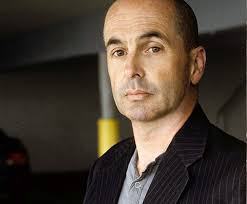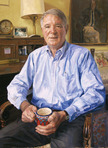William Peace's Blog, page 49
November 6, 2015
Creativity
There is a post on the Goodreads blog by Cynthia (26-10/15): “Elizabeth Gilbert’s Top 10 Tips to Stay Inspired and Kick-Start Your Creativity”
The To 10 are:
Start writing: set a timer for 15 minutes, sit down and write anything. Stuff will start to happen.
Be creative every day. Do a little bit every day.
Go looking for inspiration. Seek ideas everywhere.
Surround yourself with optimists. Pessimists should be avoided.
Dare yourself to keep working.
Trust your curiosity. If something interests you, pursue it.
Create a ritual. Research and preparation are essential.
Don’t believe in writer’s block.
Write for yourself
Imagine your reader. Tell the story to that person.
This advice is from Ms Gilbert’s book Big Magic: Creative Living Beyond Fear.
Elizabeth Gilbert
The only one of these Top 10 that I agree with whole-heartedly is no. 8: Don’t Believe in Writer’s Block. In my experience, writer’s block is a self-fulfilling prophesy. Yes, there are times when I don’t feel like writing, but rather than attributing it to writer’s block, I ask myself why I don’t feel like writing. If I’m tired, that’s not a good time to start writing. Otherwise, I’ll start trying out opening phrases in my head until one of them sounds good. I’ll type it, and see where it leads me. Frequently, when I begin to feel inspired, I’ll go back and re-create that opening phrase. In this sense, for me, creativity is a trial and error process. I’ll re-read what I’ve written, an hour later, a day later, a month later and six months later. I’ll re-read it slowly and ‘loudly’ in my mind. Anything that jars me gets attention. Maybe it’s the wrong word, or phrase or emphasis. And again, I’ll try alternatives in my mind until something clicks.
I think I know what Ms Gilbert means by ’write for yourself’. It is that one should write for personal pleasure. But then she says, “I never promised the universe I would be a GOOD writer.” If one doesn’t care about being ‘good’ at a major activity (apart from exercise) what’s the point?
In my opinion, creativity can’t be forced with timers, rituals or dares. I’m at my creative best when I’m feeling alert, unencumbered by extraneous concerns, and with no visual or auditory distractions. I’ll start the process with a question like ‘how can I make the sinister nature of this character more believable?’ Suggestions will pop into my head. I don’t grab the first one or one of the first three. I find that the suggestions help me redefine the question, making it more specific.
As I mentioned in an earlier post, I tend to be quite creative when I’m awake, in bed, in the dark, with no distractions. My mind will generate almost endless ideas. I just have to narrow down and refine the alternatives.


October 30, 2015
Review: The Power of the Dog
This novel is probably the grittiest I have read. I mean ‘grittiest’ in the sense of terse, violent and gripping. In 541 pages, Don Winslow sets out a compelling picture of the drugs wars in the America from New York City to Columbia. Nothing is withheld, abbreviated or glossed-over: the actions, reactions and motivations of dozens of very real characters. The scope of the novel draws in not only the drugs lords, the law enforcers and their subordinates on many levels, but also the politicians, and the military, so that, ultimately, it is not just about drugs, but also about perceived national interest and long term political strategy. One has to admire the depth of research Winslow must have completed to write this novel. The details of places, organisations, and procedures are all there with crystal clarity. One is tempted to believe that this is not a novel, but a description of the real world.
Don Winslow
The characterisations are excellent. There are about six characters who make it all the way through the book, and dozens more who fall (or are pushed) by the wayside. Each of the characters is distinct, and none is completely repellent: we understand their motivation even if it is just survival. The dialogue is terse, but fit for purpose.
One challenge for a reader of this novel is being able to connect the threads of location, character and motivation, as the story skips around from place to place. But Winslow is not trying to tell a simple story, and his skipping about technique reinforces the overall message: this game is very complex.
I found the book hard to put down, but when I did, I looked forward to finding out ‘what happens next’.
Winslow’s style of writing is not ‘literary’. This is not a work of literary art; it is a fast-moving story told in the street language of the characters themselves.
This book is not a pleasant read: the casual violence can be gut-wrenching, but if you are a reader with a strong stomach, and a love of realistic, complex and, ultimately, important action, this is the book for you.


October 20, 2015
A Learning Experience
As a writer, I have found it very helpful to read the work of other authors. One discovers techniques and approaches which can be very effective. My latest experience in learning from others involves not my own reading, but my wife’s reading. She has been reading a series of novels in Italian by Elena Ferrante (a pen name). She said the first in the series is extremely good; it concerns two young girls with very different personalities growing up in the 1940’s. She said the remarkable aspect of the novel is that nothing extraordinary happens, but that the writing was so good that it was captivating.
I got to thinking. How could this be? Then I realised that it wasn’t the content but rather the characters’ reactions to the content that was important. In other words, the novel constantly explored the characters’ emotions and reactions to events which, in and of themselves, were ordinary, but the emotions and reactions painted a vivid picture of the character.
I am reading a novel by Sebastian Faulks which makes frequent pauses to describe the principal character’s inner reactions to events, or to describe a relevant snippet of his history. Faulks and Ferrante are using similar techniques.
It occurred to me that, having started out as a story-teller and a writer of thrillers, I have a tendency to keep the action moving. My dialogue is crisp and to the point. The words express what the characters are feeling and they imply values. But this approach misses a dimension of richness by not pausing to see the characters more completely in their history, their personality and their values.
I am about 75% of the way through a new novel, and I’ve decided to continue with brief diversions on the characters’ feelings, history and values. But these diversions have to be succinct, relevant, and truly interesting – perhaps unexpected. My further intention is to review the 75% which is ‘completed’ and add similar passages.


October 12, 2015
Booker Prize winner
This isn’t about who I think will win this year’s Booker Prize, but about a man who thinks he knows who will win and who won money last year on thirteen bets that The Narrow Road to the Deep North, Richard Flanagan would win.
An article in The Daily Telegraph begins: “A mystery punter who correctly predicted the winner of last year’s Man Booker Prize using a formula based on ‘Sherlock Holmes deductive reasoning’ is at it again, this time staking his money on Sunjeev Sahota. The man, who goes by the name of ‘Mr Smith’, has visited a string of betting shops in and around Darlington, Co Durham, and placed the maximum stake on the British author’s novel The Year of the Runaways. Ladbrokes has reacted by cutting Sahota’s odds from 10/1 to 5/2, because ‘Mr Smith’ has form: his successful thirteen bets last year.
“The man, described as middle-aged, well-spoken and fair haired, later rang a local newspaper to disclose his methods – and the fact that he had not read any book on the shortlist. After reading online reviews of the books he picked the winner by studying Wikipedia biographies of the judges and working out which novels they would favour. ‘I never read any of the books because, quite frankly, fiction is not my thing,’ he told the Northern Echo last year. ‘I had, therefore, to spend much more time reviewing the judges than the actual books themselves. I did a case study of each judge, using Wikipedia and YouTube, and read as much as I could about the books they had written, their interests, their politics and religious beliefs and then, through a process of Sherlock Holmes deductive reasoning, tried to intuit which books they would go for.’
“His worry that female judges would not like a war story – Flanagan’s novel was about a survivor of Burma’s ‘Death Railway’ – was assuaged by the fact it ‘had a love affair inserted into it that I guessed would keep the female judges from recoiling in horror at some of the gruesome aspects of the book.’ This year, he believes the six judges will settle on The Year of the Runaways, a tale of Indian immigrants struggling to make a life for themselves in Sheffield. The string of bets, made in shops in the Darlington area and backed up by online betting, puts Sahota’s book second only to Hanya Yanagihara’s A Little Life in the Ladbrokes odds.
If you fancy taking a punt, better make it today. The winner will be announced tomorrow.


October 8, 2015
Review: Dark Waters
A friend of mine who is aware of my US Navy background, gave me a copy of Dark Waters, An Insider’s account of the NR-1, the Cold War’s Undercover Nuclear Sub. The authors are Lee Vyborny, who was a member of the NR-1 crew and Don Davis, a news correspondent.
I was interested, not because I served in submarines – I didn’t – but because I spent four years in destroyers whose mission it was to destroy enemy submarines. There were plenty of exercises during which we practiced hunting and killing submarines. One particular exercise comes to mind: my ship had just finished a refit in the Brooklyn Naval Shipyard and was sent to Guantanamo Bay for training exercises. One of our new weapon systems was AsRoc, an anti-submarine missile system which could be armed with either a state-of-the-art torpedo or a nuclear depth charge. We were also fitted with an advanced sonar system. Our first exercise one morning was to hunt down and ‘destroy’ a US Navy submarine which was playing ‘the enemy’. As soon as we were clear of the harbour, our sonar picked up the submarine at a distance of 10,000 yards (five miles). The captain sent the submarine an underwater telephone message telling them that the exercise had begun. Immediately, he fired an AsRoc with a dummy torpedo. The missile took off with a tremendous roar and splashed down within 200 yards of the submarine. The torpedo detached from the missile, energised its sonar, discovered the submarine, and ran toward it, hitting the submarine’ hull with a clang.
Dark Waters tells the story of the creation of NR-1 and its subsequent use. The motivations for designing an autonomous, deep-diving submarine were multiple. The loss of the USS Thresher with its entire crew in an accident in the North Atlantic suggested the need for a deep rescue vehicle. The deep-diving vehicles which existed in the mid 60’s were either limited in their depth capability or were tied to a surface vessel. There was also an accident involving a B-52 bomber in which a nuclear weapon was dropped into the Atlantic off the coast of Spain. How to find it in deep water? And then there were almost endless possibilities for snooping on the Soviets.
Admiral Rickover was given responsibility for the Deep Submergence Systems Project. I had an interview with the admiral in 1964 in his rather scruffy office in Washington. He was assisted by the captain of the first nuclear aircraft carrier, USS Enterprise, who was in dress white uniform; the admiral was in casual civilian clothes. “Why did you have so many D’s in college?” the interview began.”
“I don’t recall that I did, sir.”
“You did. Why?”
“I don’t know, sir.”
“Are you stupid or are you lazy?”
“I must be lazy, sir.”
“How can you afford to be lazy? Is your father a millionaire?”
“No, sir.”
“Lieutenant, let me ask you a question. Suppose your wife served a pie that was absolutely awful. What would you do?”
“Well, sir, I wouldn’t say anything and she would ask about it.”
“That may work for you, lieutenant, but let me tell you the correct answer. You should pick the pie up, throw it on the floor and say, ‘this pies isn’t fit for the dogs. Get another baker!”
I received orders to go to the nuclear submarine training school, but I resigned from the Navy.
I can say that the authors paint a very accurate picture of the man who was dogged, insensitive, brilliant and highly effective in achieving his vision. I certainly enjoyed reading more of his episodes of shameful manipulation!
The NR-1, being nuclear powered has a theoretically unlimited range submerged; it is, however, underpowered, which limits its speed to about six knots and makes it somewhat vulnerable to rough seas when surfaced. It is small: about 250 tons, 130 feet long, 13 feet in diameter, with a crew of about a dozen.
NR-1
The book covers the selection and training of the crew, what life was like on board and some of the assignment which NR-1 was given. One of the assignments, for example, was the recovery of a US Navy F-14 jet fighter and its highly classified air to air missile. Both were lost in a launch accident off the west coast of Ireland. The recovery was severely complicated by the presence of the Soviet navy which also wanted to make the recovery. Its classified missions (and there must have been some of them) are not discussed. One point which stands out for me is the many mishaps that befell NR-1. In fact, the authors say: “Few ships in naval history would have as many close calls, repeatedly, over many years, than its smallest nuclear-powered submarine.” I often wondered, when reading: couldn’t that problem have been eliminated by design?
The book is certainly well-written: the technology is understandable, the human interactions are revealed with particular skill, and the pace of the story is about right. I felt that there was not enough ‘meat on the bones’: the most exciting episodes involved malfunctions of NR-1 rather than espionage derring-do. (Probably because the Navy wouldn’t grant permission for those episodes to be published.) Having said that, for those who have in interest in submarines, it is recommended reading.


September 25, 2015
The American Family
I had a call from a friend of mine. He said, “I found one of your manuscripts.” (This is a friend to whom I’ve given early drafts of my work.)
“Did you, Peter?” I coaxed.
“Yes, and I think it’s very good indeed.”
“In what way?”
“Well, it depicts the American family in a way that’s both real and stimulating.”
Typical American Family?
I thought: I haven’t written anything about the American family. He must be looking at someone else’s manuscript.
“Are you sure it’s mine, Peter?”
“Yes, it’s Sable Shadow and The Presence.”
So, I thought, he must have picked it up again three or four years after I sent it to him.
“Do you want it back?”
“No that’s fine, Peter. You can keep it.”
This incident got me thinking about that particular novel. It isn’t really about the American family. Rather, it’s the story of one man’s struggle with good and evil, success and failure. But at the same time it is populated with characters, all of whom are American, and who make up his extended family. His mother is a rather distant woman, more concerned with her social life than with her children. Henry’s father is an alcoholic who has failed in his career ambitions, and while seemingly remote from his children is intensely proud of them. Henry’s sister is bright, aggressive and with all the self-confidence that Henry lacks.
Henry’s wife, a psychologist, is also unsure of herself, but she places all her confidence in her husband. Their children are William and Helen. William is adored by his father, and represents ‘all that I wish I could have been’ in a reflection of the relationship between Henry and his father. Helen is a blonde gay beauty who goes through the agonies of coming out to her parents and finding unexpected acceptance.
Henry has two domineering grandfathers: one very wealthy who manages to lose it all, and the other an autocrat who dedicates himself and his family to his alma mater, Notre Dame.
Apart from the family there are several positive role models for Henry and two malignant influences. These two are the last CEO of the corporation for which Henry works, and a female employee who has sexual designs on Henry.
Putting these characters together was not a difficult task. They seemed to come alive on the page. Perhaps this process was facilitated by similar people and relationships I have experienced, though the novel is not autobiographical – even though it is told in the first person.


September 19, 2015
Authors Prohibited from Writing Blurbs
Brooke Warner, of hybrid publisher She Writes Press, recently posted a blog on the HuffPost Books US website in which she was very critical of traditional publishers. What happened was that a traditionally published author agreed to write a blurb for a book that was to be published by She Writes Press. The author checked with her editor at one of the big five publishing houses and the blurb was pulled.
Brooke Warner
The reason for the decision is that there is a difference in ‘values’ between traditional publishers and other publishers: traditional publishers believe that “publishers should invest in authors, but authors should not invest in themselves”.
My reaction: this makes no sense at all! Why should authors be prohibited from investing in themselves?
Ms Warner said: “What should matter about a book is how well written it is–not the author platform or brand or how many followers a would-be author has. And yet, from a business perspective, of course it makes sense that this is what publishers today must focus on–or risk decimation. I left traditional publishing after a particularly symbolic experience, when I was actively discouraged from acquiring a book I believed in wholeheartedly but then met with excessive enthusiasm (and a large advance to back it) for a proposal propelled by a fancy agent, celebrity endorsements, and a whole lotta hot air. It wasn’t cannon fodder, and it ended up doing well for the company, but I’d compromised. I left three months later.”
She continues: “If you are asked to blurb a book, what should matter is whether you believe in it. If you don’t, you don’t blurb it. If you care enough about the author or the book, you offer your endorsement. End of story. It’s your choice. A blurb is a gift to the author. Authors do not pay for blurbs. They work hard to get them because the industry tells authors that they matter, that they sell books. She Writes Press authors have scored amazing blurbs–blurbs from New York Times best-selling authors and champions of people’s dreams. A publishing company, in my opinion, does not have the right to mandate whom its authors advocate in an attempt to control its reputation or to distance itself from “the other.” To do so smacks of elitism, one of traditional publishing’s lasting and detrimental flaws. We’ve already arrived at a place where people judge books on the writing, not on how those books make it into the marketplace. It’s time for traditional publishing to catch up, to pull its head out of the sand. That it’s lost sight of publishing’s mandate–to champion good books–speaks to its values. And those are values I certainly don’t share.”
Ms Warner – she was apparently quite angry when she wrote the blog – then mentioned a specific example of the ‘values’ of the big five: “Simon & Schuster has a self-publishing imprint called Archway, run by Author Solutions (of very questionable ethics who’ve been sued by authors and whose track record you can Google), which, awkwardly and oddly, is owned by Random House/Penguin. (Apparently Simon & Schuster has no qualms about the self-publishing arm of their business being owned by their biggest and direct traditional competitor.) One of the great promises of Archway is that you might get published by Simon & Schuster–if your book sells well enough. But their traditionally published authors apparently can’t and won’t blurb you. So there you go–you’re the pissed-upon little sibling. They happily run a self-publishing imprint, but they do whatever they can to distance that “subset” from the preferred children.
The war between the traditional press and the ‘upstarts’ is heating up!


September 12, 2015
Review: Remains of the Day
This ‘modern classic’ was first published in 1989, and won the Booker Prize that year. While I had heard of the novel, I had never read it; I was further motivated to read it as a Booker Prize winner and by the author being a Japanese writer I didn’t know.
Kazou Ishiguro was born in Nagasaki, Japan in 1954 and moved to the UK at the age of five. He has written six novels, all of which have won prizes or received major recognition. He currently lives in London with his wife and daughter.
Kazou Ishiguro
The novel is told in the first person by Stevens, who was the butler in Darlington Hall, which was the residence of Lord Darlington in the 1930’s. Darlington Hall was a grand place, with many servants, Stevens having overall responsibility. Lord Darlington was a man of considerable wealth and influence, both socially and politically. He died after the war, and Darlington Hall was sold to an American, Mr Faraday, who has downsized both the staff and the use of the Hall.
Much of the book is Stevens’ recollections of events that took place when his lordship was in residence, and we learn that Stevens is preoccupied with the extent to which he was (like his father) a top butler. Stevens comes to define a top butler as a true professional who carries great dignity to his profession. The descriptions of relationships (and dialogue) among staff and with the lord of the manor are brilliant: they convey clearly the culture of the English aristocracy in the 20’s and 30’s.
Mr Faraday plans to be in the States for an extended period, and he suggests to Stevens that he take the motorcar on a sightseeing trip. Stevens accepts his offer and coincidently decides to call on a Miss Kenton who was the one who supervised all the housemaids at Darlington Hall. Miss Kenton left the Hall years ago, and has married. Now, Stevens wonders whether he can persuade her to return to the Hall, as there are hints that her marriage is in difficulty. The working relationship between Stevens and Kenton was very formal, but one cannot help but wonder if there is an unacknowledged attraction between them. In the last chapter, they meet again, and the message of the novel is revealed: Stevens muses: “After all, what can we ever gain forever looking back and blaming ourselves if our lives have not turned out quite as we might have wished?”
The novel moves at a very leisurely pace, with very little action. Major events are recounted by Stevens factually and without emotion. The characters, the setting and the story-telling all completely support that retrospective, self-doubting theme. In spite of Stevens’ wordiness, his character shines through in a way that he is able to maintain the reader’s attention.
If one is looking for tale with plenty of action and excitement, The Remains of the Day would not be a good choice. But if one would like to curl up with a superbly-written story, immersed in history, and long-forgotten characters, a story that succeeds admirably in making its point, then Remains is for you.
As a sort of aside, I would add that the criteria for winning the Booker Prize may have shifted over the last twenty-five years. It’s hard to imagine that a novel with little overt physical or emotional action could win, given the level of current competition.


September 3, 2015
The Guilty Secretes of E-book Readers
There was an article in The Daily Telegraph last week which reported on the popularity of titles of e-books vs titles of physical books.
“A newly published list of Amazon.co.uk’s biggest selling e-books of the year features psychological thrillers, misery memoirs, Mills and Boon and a book by the Tory MP Nadine Dorries, whose first work was memorably described by a Telegraph reviewer as “the worst novel I’ve read in 10 years”. Notably, 18 of the top 20 authors were women, including thriller writers Angela Marsons, Fiona Neill and Rachel Abbott.
“However a parallel list of physical books compiled by Waterstones to cover the same period is significantly more highbrow, and features four times as many male authors. They include Richard Flanagan, author of the Man-Booker Prize-winning The Narrows Road to the Deep North, and Anthony Doerr, with his All the Light We Cannot See. There were also books by Colm Toibin, Ian McEwan and Victoria Hislop. The print list is topped by Harper Lee’s Go Set a Watchman, which does not make the Amazon e-books list.
“There is some overlap. Paula Hawkin’s runaway bestseller The Girl on the Train, and the latest risqué offering form E L James appear in the top three of both lists. But the disparity between the books we put on show and those we download suggests that e-book reads can be ‘guilty pleasures’.
“Benedict Page of The Bookseller said: ‘There are certain kinds of books that people like to own. If they have a favourite heavyweight literary author who they have followed for many years, they are likely to want to possess the printed book because it’s beautiful and durable and represents a readerly commitment.'”
I think that Page’s analysis is probably correct in that we tend to regard e-books as disposable, and printed books something to be retained. The high proportion of female writers on the e-book list is interesting. My theory would be that at least some of the female authors on the e-book list write primarily for women, and are more interested in achieving volume than literary recognition. I’m also guessing that more women than men own e-book readers. These two theories seem to converge on the supply and demand sides.
What’s your view?


August 27, 2015
Review: Writing with the Master
This is the true story of a retired businessman who’s been writing novels and having them rejected by publishers/agents. The businessman’s friend John Grisham (the best-selling author) offers to coach him in the writing of a new novel. The book sets out, in detail, all of the coaching provided over two years.
Tony Vanderwarker John Grisham
Tony Vanderwarker is a retired advertising executive who had his own, very successful, ad agency, sold it and moved from Chicago to Charlottesville, Virginia with his family. John Grisham, also a Charlottesville resident, is a friend of Tony’s, and one day, over lunch, John offers to ‘mentor’ Tony in writing a new novel. Grisham had previously referred one of Tony’s works to an agent whose review was positive, but not quite good enough to be published.
The process started with John asking Tony what he wanted to write about. Tony’s first two ideas were rejected out of hand. His third idea was a thriller about nuclear weapons lost by the US Air Force in air crashes where the weapon was not recovered. There are nearly a dozen such weapons, dating back to the 1950’s. Tony prepared a three sentence description of the plot and then a full, multi-page outline. At each stage we see portions of what Tony has written and John’s written critiques. The critiques are blunt and to the point. After three and a half months of trial and error, Tony revises his plot outline, and is ready to start chapter outlines. During this process, we see a reflection of the way John Grisham writes his novels. First, a one paragraph outline: is it interesting enough, strong enough? Then the three page outline, complete with characters: do the subplots support the main plot or are they extraneous? Are the events credible? Are the characters interesting and likeable? Then comes the first draft of the manuscript. In Tony’s case, John tears into the manuscript and points out a number of problems:
the writing is sloppy: there are repeated words and phrases and factual inconsistencies.
there are too many distractions to the basic plot
the actions of a key character don’t make sense
too many bad guys
minor character isn’t fully credible
inserting the author’s political views into the story
make the dialogue real: repeat it out loud.
Show! Don’t Tell!
Tony is absolutely gutted by this critique! He turns his attention to the notes John has written on individual pages of the manuscript. Here, again, we see the text and the comment. Tony divides the manuscript into seven piles and begins the task of rewriting, which takes a year. Once again Grisham responds with a cover letter describing his principal concerns and returns the manuscript with page-by-page comments, including:
too many detours; too much backfilling
don’t be afraid to cut
not allowing the suspense to build
Tony makes the suggested changes and submits the manuscript to John’s agent, who likes it and refers it to another agent because it doesn’t fit for him. The agent to whom it is referred is very complimentary but declines. Tony goes back to the default mode of mass submissions, without success.
When Tony has essentially given up on getting his novel published, he gets a great idea. Why not write a book about the process that he and John Grisham have been through. Grisham agrees, and the book is published by Skyhorse Publishing, who also agree to publish the mentored novel: Sleeping Dogs.
For anyone who is interested in the process of writing fiction, this book is a must read. And for those with only a passing interest in the creative effort, there is enough of the rest of Tony’s life fitted neatly in to make to book a good read: his life as an advertising executive, his work for an environmental charity, his relationship with his wife and the Charlottesville area.
Personally, I’m not surprised that Sleeping Dogs didn’t get published on the first attempt. From my point of view, there’s too much that stretches credibility. But, I’m not surprised that Skyhorse decided to take it up. Writing with the Master is a great promotion for Sleeping Dogs.
As for John Grisham’s advice, I think that ninety percent is spot on. Two quibbles: I believe in outlining, but not to the extent that John does. I think that detailed outlines can stifle creativity, and I notice that Tony has reached a similar conclusion. There’s not much in John’s advice about the use of creative language, which I think is important to differentiate the writer and his/her text from the mundane.
Tony writes well, and I’m glad that he decided to follow-up on his brainstorm: why not write a book about the mentoring process?













